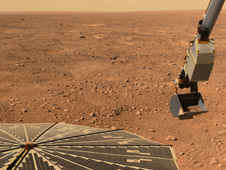Microsoft over the moon with NASA imagery
WorldWide Telescope gets access to new Mars and Moon pictures

Microsoft and NASA today announced plans to make planetary images and data available on Microsoft's online virtual star-gazing software WorldWide Telescope.
The two organisations will jointly develop the technology and infrastructure necessary to make "the most interesting NASA content", such as high-resolution scientific images and data from Mars and the moon, explorable on WorldWide Telescope.
Under the agreement, NASA's Ames Research Center in Moffett Field, California, will process and host more than 100 terabytes of data. WorldWide Telescope will incorporate the data during 2009 and feature imagery from NASA's Mars Reconnaissance Orbiter (MRO) and Lunar Reconnaissance Orbiter (LRO), when data is publicly released starting this autumn.
Martian media
MRO has been examining Mars with a high-resolution camera and five other instruments since 2006 and has returned more data than all other Mars missions combined. The LRO is scheduled to launch this May, to spend at least a year in a low, polar orbit approximately 30 miles above the lunar surface.
This agreement builds on a prior collaboration with Microsoft that enabled NASA to develop 3-D interactive Microsoft Photosynth collections of the space shuttle launch pad and other facilities at NASA's Kennedy Space Center in Florida.
Ames is also developing a suite of planetary data processing tools to convert historic and current space imagery data into a variety of formats and images of the moon, Mars and other planetary bodies.
Get daily insight, inspiration and deals in your inbox
Sign up for breaking news, reviews, opinion, top tech deals, and more.
"NASA has a wealth of images and data, from the Apollo and Lunar Orbiter missions to Mars Reconnaissance Orbiter and the Mercury Messenger flybys," said Chris Kemp, chief information officer at Ames. "This collaboration makes it possible for NASA to leverage exciting new Microsoft technologies to make NASA's data - and America's space program - more accessible to the public."
You can download the free WorldWide Telescope software at www.worldwidetelescope.org and find out more about NASA at http://www.nasa.gov.